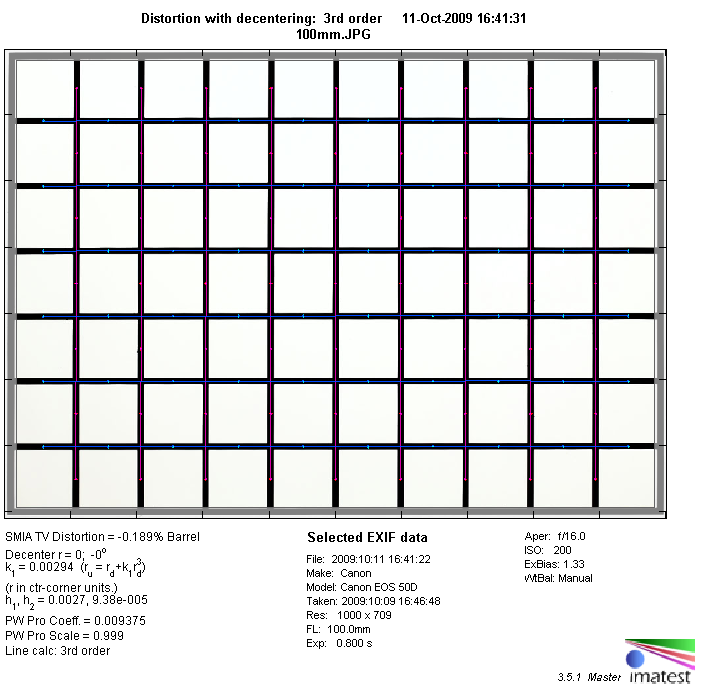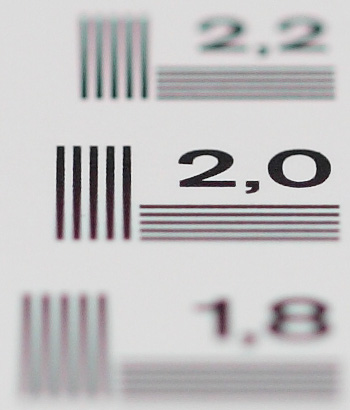|
Canon EF 100mm f/2.8 USM L IS macro (APS-C) - Review / Lab Test Report - Analysis |
|
Lens Reviews -
Canon EOS (APS-C)
|
|
Page 2 of 2

Distortion
Typical for most macro lenses the level of distortion is negligible and nothing to worry about. Interestingly the APS-C figures are slightly worse (if we can speak of "worse" on this level) compared to the full format test so there seem to be some marginal distortion in the inner image field which are corrected beyond again.

The chart above has a real-world size of about 120x80cm.
Vignetting
The lens enjoys the usual sweet spot advantage when used on an APS-C DSLR. The amount of vignetting is still comparatively high at f/2.8 though. In critical situation, e.g. in a scene with clear sky, you may be able to spot this. However, the problem is already negligible from f/4 onwards.

MTF (resolution)
The resolution characteristic of the Canon L lens is very impressive in the APS-C scope. The center quality is excellent straight from f/2.8 till f/8. The borders are slightly worse but still easily on a very good level in this range. Starting from f/11 onwards there's the general decrease in quality due to diffraction effects. However, the lens remains easily usable at f/16. f/22 is a no-go - the diffraction characteristic of an APS-C body is not as favorable as on full format DSLRs here.
Please note that the MTF results are not directly comparable across the different systems!
Below is a simplified summary of the formal findings. The chart shows line widths per picture height (LW/PH) which can be taken as a measure for sharpness.
If you want to know more about the MTF50 figures you may check out the corresponding Imatest Explanations

Chromatic Aberrations (CAs)
Lateral CAs are generally well controlled with around 1px on the average at the image borders. At 100% magnification you may spot this but it shouldn't be a problem on prints.

Bokeh
The bokeh (the quality of the out-of-focus blur) is a primary aspect for a macro lens and the Canon lens does truly shine here. Out-of-focus highlights are very uniform and perfectly circular till f/5.6. The critical focus transition zones are very smooth at max. aperture. It's one of the best lenses in this respect that we've seen so far.

Bokeh Fringing / Longitudinal Chromatic Aberrations (LoCA)
Bokeh fringing is a common problem present in most large aperture lenses and despite its UD element the 100mm L IS is no exception to the rule here unfortunately. At f/2.8 the fringing is quite significant - if you observe the provided sample crops below you will be able to spot the green (rear) & purple (front) halos in the focus transition zones. They are quite pronounced at f/2.8 but the situation improves at f/4 and the problem is basically gone by f/5.6.
|
Move the mouse cursor over the f-stop marks below to observe the respective LoCAs
|
| f/2.8 |
f/4 |
f/5.6 |
|

|
Here's a real world example of the problem (at f/2.8):

Sample Shots
You can find some sample images in the Canon full format test section.
VerdictThe Canon EF 100mm f/2.8 USM L IS macro has a comparatively easy play in the APS-C arena. The center to corner resolution is very high up to f/11 and even f/16 is a perfectly usable setting here. Typical for macro lenses distortions are a non-issue. Vignetting is only a slight problem at f/2.8. Lateral CAs are well controlled although potentially (just) visible at the borders. The quality of the bokeh (out-of-focus blur) is excellent and among the best that we've see here. Unfortunately there's still some bokeh fringing which may spoil the game a little at f/2.8, less so at f/4. Technically the lens is probably not superior to the conventional 100mm f/2.8 USM macro but it offers a slightly better build quality and the new hybrid IS. The AF performance is about on par and as such vastly better than third party alternatives. Not an easy decision ...
|